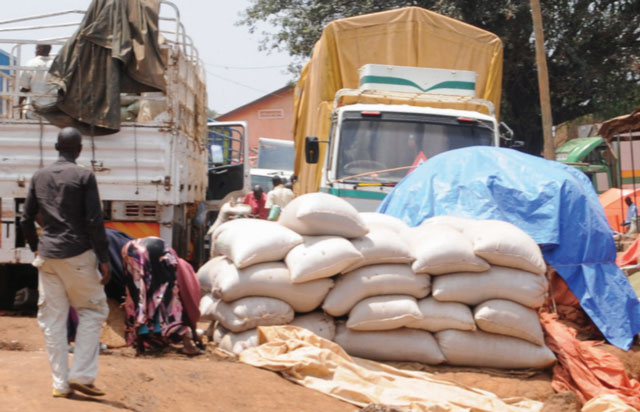
Maize prices drop by 70% as exports to Kenya reduce due to political uncertainties
Kampala, Uganda | JULIUS BUSINGE | Uganda’s farmers could battle to sell some of their surplus maize as major customers who mainly export to Kenya cut back on their purchases citing political uncertainties in the latter country.
The country’s maize oversupply has led to prices falling by 71% in the first season of 2017 to Shs 700,000 per tonne compared with the same period in last year amidst effects of drought and army worm.
While statistics on the volume of exports to Kenya remains scanty, data from the Uganda Bureau of Statistics (UBOS) indicates that the country produces more than four million tonnes of maize per annum.
Of this, more than 80% is exported as grain informally and formally to regional markets of Kenya, South Sudan and Rwanda, earning the country close to US$50 million on average per annum in the last five years.
In an interview with The Independent on Oct. 12, Julius Mukasa, the coordinator of Maize Exporters in Uganda, which consists of 80 middle men dealing in maize trade on behalf of their Kenyan counterparts, said they have not purchased any grain in the country and are not sure when they will.
“…because of political uncertainties in Kenya we had to cancel all orders until the situation normalises,” he said, adding, “Our dealers in Kenya fear that trucks can be attacked on the way.”
The exporters, Mukasa said, buy more than two million tonnes of maize from Uganda and export to the neighbouring country per annum.
Kenya has just held a repeat poll but the National Super Alliance leader, Raila Odinga and his running mate, Kalonzo Musyoka withdrew from the race against the incumbent Uhuru Kenyatta of the Jubilee Party citing Independent Electoral and Boundaries Commission (IEBC) reluctance to heed their call for reforms.
It is Odinga that went to the country’s Supreme Court that the August 8 presidential election nullified over failure to follow the set procedures.
Mukasa said some traders who had stocked the grain in June hoping for a price hike have now put it on the market because of the poor demand locally and in the region.
With the absence of the Kenyan market, Mukasa said it is only schools, prison authorities and relief agencies that are key buyers of maize in the country at the moment in addition to some households in urban centres. These account for only 20% of the total maize production per annum.
Chris Kaijuka, a board member of the Grain Council of Uganda, a market intelligence and business development firm told The Independent that Uganda’s maize exports to South Sudan, another key market for Uganda’s maize has been declining due to political instabilities which reduced people’s purchasing power.
However, he said that Ugandan farmers are still making profit at the moment given that a kilogram costs Shs 400 to produce, which is almost half of the Shs 700 market price in most parts of the country.
Kaijuka said the price of maize for this season and the year is likely to remain low because of the uncertainties in the regional markets and the fact that Ugandan maize is of poor quality.
Going forward, Kaijuka said the government needs to train farmers on modern methods including planting high yielding varieties, fertilizer application as well as investing good storage facilities.
“Roads need to improve to facilitate transportation and marketing of the maize and cross-border trade must be monitored to deal with informal traders,” he said.
“Without that, our maize will continue not to attract buyers in the region. Organised buyers want high quality maize…not the one that is dried on bare ground.”
National Grain Policy
In a recent interview with The Independent, Khadija Nakakande, the publicist of the Ministry of Trade Industry and Cooperatives said they are aware of the challenges in the maize sub-sector.
“…..that is why we came up with the national grain policy of Uganda which is currently in its early stages of implementation,” Nakakande said.
The policy intends to support the over 2.5 million households that derive their income from maize. It is covering areas of value addition, storage, standards, and promoting fair trade locally and amongst East African partner States. The policy is also looking at issues of farmer’s cooperatives, enhancing access to affordable inputs in addition to searching for competitive markets for the grain among others.
In Uganda, maize is grown in most parts especially in the Eastern region (Kapchorwa, Mbale, Kamuli, Jinja, Iganga); Central region (Masaka,Mubende, Mityana) and Western region (Kibaale Masindi, Kamwenge, Kyenjojo, Kasese and Kabarole).
Quick 5-year facts
- A quick analysis of formal export numbers from the Uganda Bureau of Statistics indicates a 62% growth in exports in 2015 up from 43% in 2014, 9% in 2013 and 48% in 2012.
- In terms of value, the country earned a huge $91 million in 2015 up from US$43 million in 2014, US$42 million in 2013, US$56 million in 2012 and US$26 million in 2011.
 The Independent Uganda: You get the Truth we Pay the Price
The Independent Uganda: You get the Truth we Pay the Price


